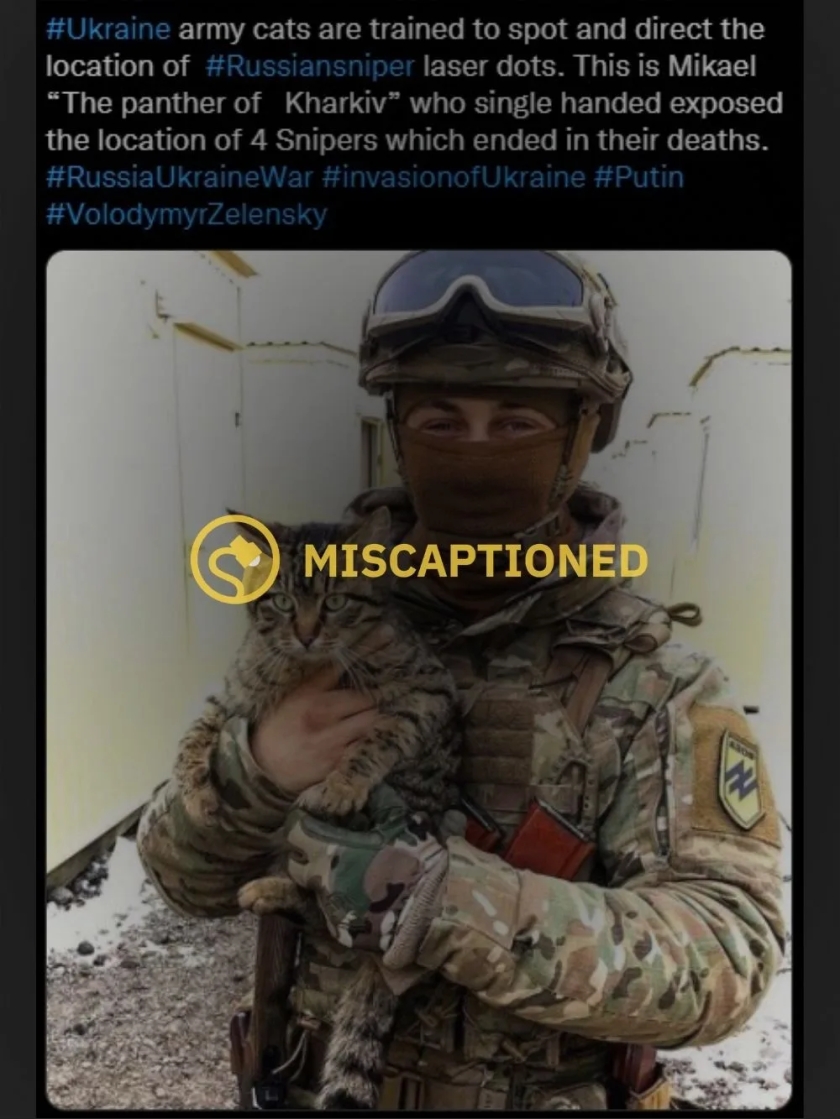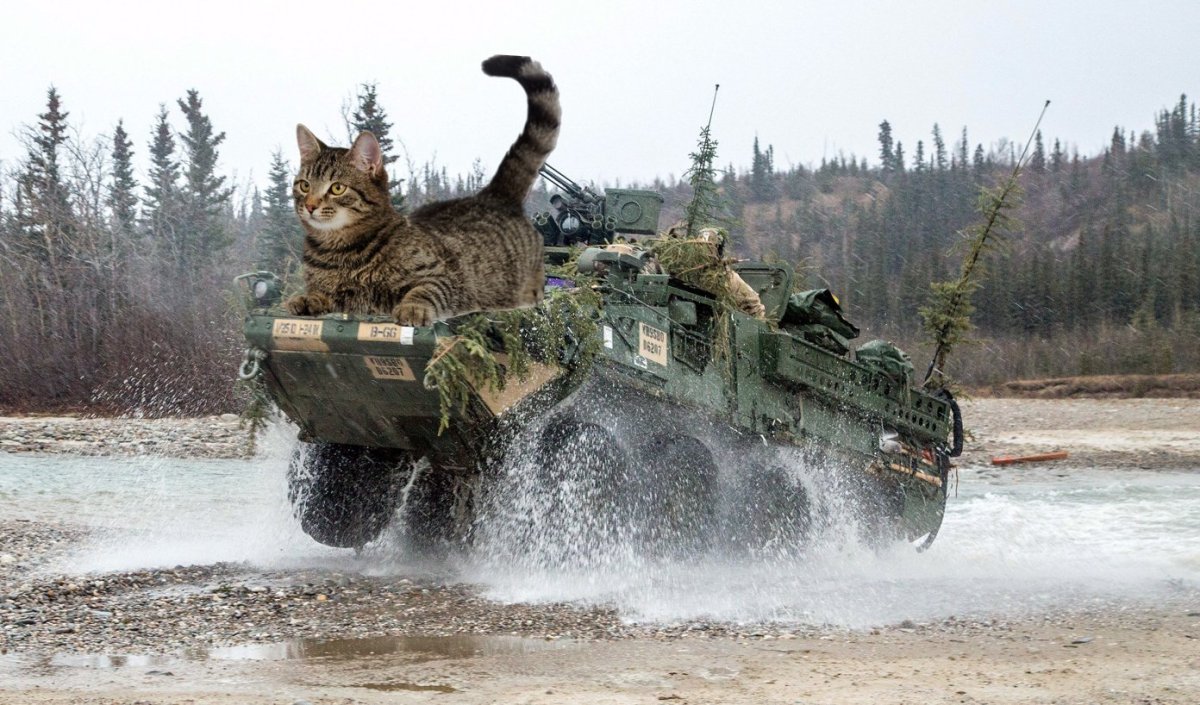According to the legend of the “Panther of Kharkiv,” a vengeful house cat has been using his superior feline vision to spot the telltale red laser dots from sniper scopes and warn Ukrainian soldiers they’re targets before snipers can get off a shot.
I imagine it goes something like this:
“Dude, there’s a red dot on your face.”
“You said that 42 times in the last hour.”
“Well, it’s true. Give me my treat as a reward, otherwise I might forget to inform you next time.”
“If I find out you’re lying…”
“Treat, now! Thanks…Mmmm, that’s good. Oh look, there’s another red dot on your head! Quick, take cover and give me another snack!”
Either that or kitty is just launching himself at Ukrainian foreheads, chasing the ever elusive red dot.
Of course you don’t need us to tell you this viral social media story is nonsense, do you?

Hundreds of thousands of people have proven themselves more credulous, and continue to share the Panther of Kharkiv posts on Twitter, Facebook, Instagram, Youtube, TikTok and other platforms despite warnings that the story isn’t true. The accompanying photo, while real, is from 2018.
“Complete garbage,” is how Liam Collins, a West Point faculty member and former defense advisor to Ukraine, put it.
Others see these stories as evidence of new frontiers for psychological operations, propaganda and counter-propaganda.
Psy-ops have long been a part of war, from Alexander the Great’s armies leaving giant-size helmets and breastplates in the ruins of conquered cities to seed tales of impossible huge — and unbeatable — Greek invaders, to a CIA-devised plan to drop condoms on Soviet territory.
“Condoms?!?” you ask. “How exactly do condoms help a war effort?”
Because they were intentionally manufactured in ludicrously huge sizes marked “Medium” and “Small” with “MADE IN USA” prominently stamped on the packaging, which would be left for the enemy to discover and, the thinking went, to kill their morale. (There are also reports that US psyops left footlong condoms on the Ho Chi Minh trail in Vietnam, leading terrified Vietcong to hide their women.)
And, famously, US Army psyops drove around in up-armored Humvees during 2004’s bloody battle of Fallujah, blasting the South Park creators’ “America, F— Yeah!” from military sound systems as Marines engaged insurgent forces.
The point is to raise friendly morale, destroy enemy morale, or both, and it makes perfect sense that psyops would move into the digital domain in a war in which cyber warfare has become a major part of the hostilities.
The Panther of Kharkiv, like tall tales of wars past, collapses under scrutiny.
As Snopes correctly notes, snipers don’t actually use little red laser dots. Not only would they be counter-productive at the distances snipers work, when things like atmospheric conditions and wind speed come into play, but using lasers would alert the enemy that they’re being targeted and give away the location of the sniper(s).
The entire point of a sniper is to take out targets over long distances without giving themselves away. They’re not equipped for routine firefights, and the last thing they want is to be stuck somewhere relying on a sidearm while riflemen flank them. That’s asking to get killed.
The second absurdity is the idea that cats can be reliably trained to do anything of military value. The CIA already tried that in the 1960s with Project Acoustic Kitty, when they outfitted cats with listening devices and released them in the vicinity of Soviet targets in an attempt to eavesdrop on their conversations.
Twenty million dollars, a few years and several failed attempts later, the CIA concluded training cats as spies was “not practical.” The problem, of course, is that you can train cats all you want, and maybe the cats even have the best intentions, but then…Oh hai is that a bird? Is that a bird? Yes, it is! I’m chasing the bird! Wait, birdie! Oooh, what’s this on the ground? A bag with a half-eaten burger? How delicious! …
Cats are easily distracted, easily bored, driven to do their own thing, and not really open to suggestions when it comes to telling them where they should walk or lounge.
The Panther of Kharkiv joins The Ghost of Kyiv as a creation of social media, wish-fulfillment figures of legend for the age of information. The latter has been earning praise as a supposed ace fighter pilot who has been terrorizing Russian Su-35 pilots from the cockpit of a Soviet-era MiG-29.
A surprisingly realistic video of the legendary pilot has been making the rounds on social media, but the footage is actually from Digital Combat Simulator (DCS) World, a game made by developers so obsessive that they even model things like the effect of recoil from mounted guns on aircraft operation.
In the viral video, a Su-35 screams overhead as two Ukranians chatter in the background. A shaky camera tracks the jet until a missile fired from out of the frame blasts it to pieces. The MiG-29 follows a millisecond later, dipping its wings in a celebratory gesture as one of the observers says “Oh shit!”
When a simulator looks like this, it’s easier to understand how people could mistake out-of-context, long-range footage for the real thing:
Now if you put a cat in that footage, wearing goggles and flying wing, people would know it’s fake. On second thought, maybe they wouldn’t.

